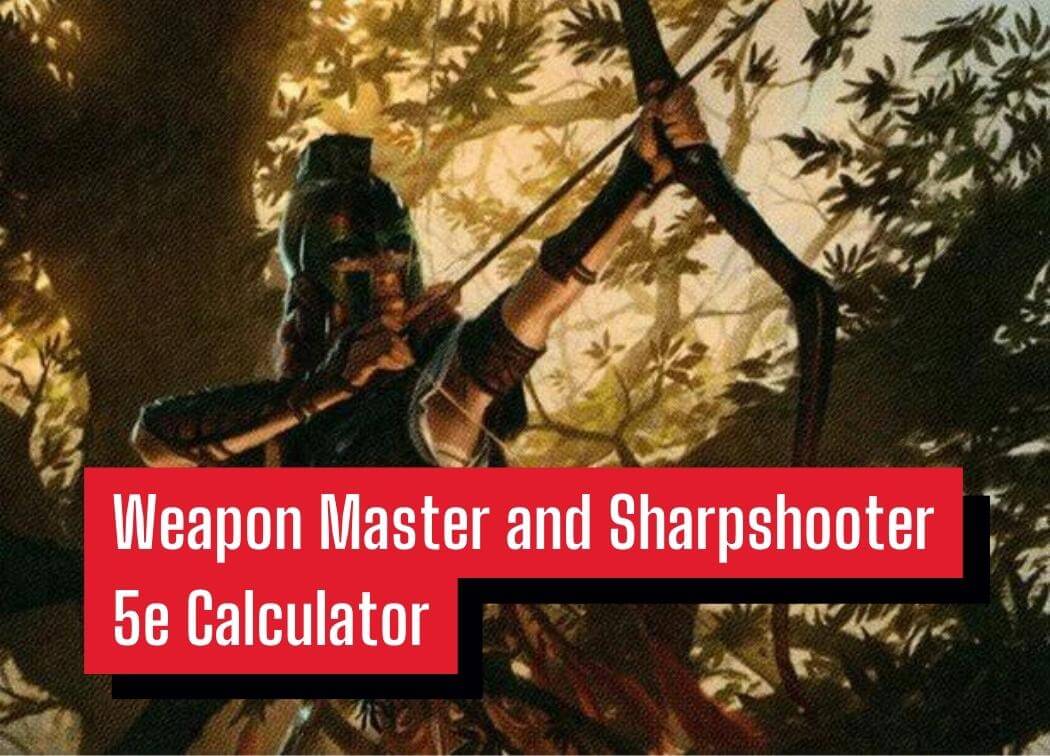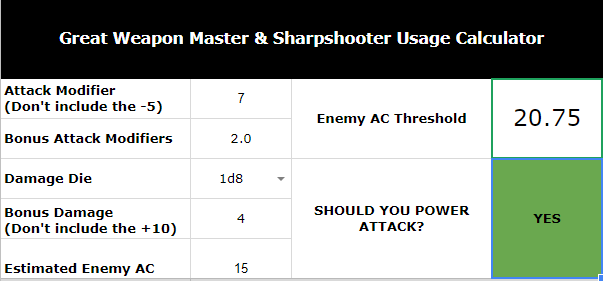Great Weapon Master and Sharpshooter 5e Calculator

The Great Weapon Master and Sharpshooter feats are two of the most powerful feats in D&D 5e. They allow you to make an attack at a reduced chance to hit in order to deal a considerable amount of bonus damage.
I’m currently playing an Arcane Archer Fighter that has the Sharpshooter feat. I wanted a way to figure out when I should be using my Sharpshooter feat in battle as opposed to a regular attack. That lead me to create this spreadsheet.
Since this article was originally posted I’ve released a Battle Master Fighter build that uses the Great Weapon Master feat.
The Feats
Both of these feats have perks other than increased damage. This post and the spreadsheet, however, will focus on the damage-dealing portion of both feats.
Great Weapon Master – PHB pg167
- On your turn, when you score a critical hit with a melee weapon or reduce a creature to 0 hit points with one, you can make one melee weapon attack as a bonus action.
- Before you make a melee attack with a heavyweaponthat you are proficient with, you can choose to take a -5 penalty to the attack roll. If the attack hits, you can add +10 to the attack’s damage.
Sharpshooter – PHB pg170
- Attack at long range doesn’t impose disadvantage on your ranged weapon attack rolls.
- Your ranged weapon attacks ignore half cover and three-quarters cover.
- Before you make an attack with a ranged weapon that you are proficient with, you can choose to take a -5 penalty to the attack roll. If the attack hits, you add +10 to the attack’s damage.
Use Case
The optimal way of using Great Weapon Master and Sharpshooter is to use them when the damage outweighs the increased chance of missing. As stated in the description of both feats, you have to declare that you are going to be using Great Weapon Master or Sharpshooter before you attack.
This presents an element of risk. The +10 damage is very powerful, but a -5 penalty to hit does make you considerably less likely to hit than you normally would be. In order to confidently use either of these feats, you have to first determine the target creature’s AC.
DO NOT METAGAME TO DETERMINE AC!
Here are two ways you can go about determining a creature’s AC that is fair to the game.
- Ask the DM for a description of the armor the creature is wearing, or if they have noticeably tough skin (natural armor). This provides a role-playing opportunity as well!
- Take note of the attacks. If you notice that an attack roll of 14 hits the creature, but 12 misses you know that the creature’s AC is either 13 or 14.
The Spreadsheet
I did some research online to determine how I should go about calculating my target AC. I found the formula here. Desamir, the author of the formula goes into detail about how they went about creating the formula. It’s a great read if you want to learn more about the formula than the overview that I will be giving!
Definitions
Attack Modifier: Your attack modifier which can be calculated by adding the appropriate stat (STR or DEX), your proficiency, and any additional bonuses such as the Archery Fighting style. Do not account for the -5 to attack in this cell, it is already in the formula.
Bonus Attack Modifiers: Any magical effects that increase or decrease your attack should be input here.
Damage Die: Select from the damage dice I have listed. I have converted these dice in the formula to use their average rolls so you cannot input your own.
Bonus Damage: Any damage modifiers such as your ability modifier should be included here. This also includes any magical effects that increase or decrease your damage. Do not account for the +10 damage in this cell, it is already in the formula.
Example: a +2 longbow gives +2 damage. A character using this with 18 Dexterity will have +6 bonus damage.Estimated Enemy AC: The AC of your target. This is an optional cell.
Enemy AC Threshold: The value in this cell is the point where you can optimally Power Attack (-5/+10). If you are attacking an enemy below the Enemy AC Threshold it is worthwhile to Power Attack. This is calculated based on your Attack Modifiers and Damage information that you input into their appropriate cells.
Power Attack: A -5/+10 attack using either the Great Weapon Master or Sharpshooter 5e feats.
SHOULD YOU POWER ATTACK?: This outputs either a yes or a no. If the Estimated Enemy AC is lower than the Enemy AC Threshold, the box will be colored green and say “YES”. Otherwise, the box will be colored red and say “NO”. This is an optional cell.
The Formula

The attack bonus is your character’s attack modifier not including the -5 penalty to hit from either Great Weapon Master or Sharpshooter. This is subtracted by the average damage your weapon deals (not including the +10) divided by 2. Finally, we add 16 which is the calculated constant.
This formula determines what the Maximum AC is that you should attack with a Power Attack rather than a regular weapon attack. As long as the AC of your target is lower than the Maximum AC you calculated, you should Power Attack.
For example, if the output is 18.5 if the target’s AC is 18 or lower you should Power Attack.
Here’s an example calculation using my Arcane Archer’s bonuses:
- +4 Dexterity Modifier (applied to both attack and damage)
- +3 Proficiency
- +2 from the Archery Fighting Style
- Longbow that deals 1d8 damage (4.5 average)
Maximum AC = 4 + 3 + 2 – (8.5 / 2) + 16
Maximum AC = 9 – 4.25 + 16
Maximum AC = 20.75
Based on this calculation I should be Power Attacking any creature with 20 or lower AC.
Conclusions
My friends and I did some extensive testing to ensure that the spreadsheet made sense and was accurate. Through this, we came upon some interesting findings. Between Great Weapon Master and Sharpshooter, Sharpshooter had a noticeably higher AC Threshold. This was due to two reasons.
The first reason was that ranged weapons on average deal less damage than heavy melee weapons. Ranged weapons deal between 1 and 1d10 damage. Heavy weapons deal between 1d10 and 2d6 damage. Because ranged weapons generally deal less damage, it is more attractive to try to fish for that +10 damage using Sharpshooter. Since heavy weapons deal more damage on average, the formula places more value on a hit with a heavy weapon.
The second reason is that Fighters and Rangers have access to the Archery Fighting Style. This grants them a +2 to hit when using a ranged weapon. In 5e RAW there is no such bonus strictly for heavy weapons.
Feel free to give me any suggestions or additional features you might have for the spreadsheet. I may continue working on it as this is a fairly rough draft on my end.


Your average damage should include any bonuses to damage, including your dexterity modifier. This is supported by the gitp post.
Thanks
Thanks for pointing that out! I edited the post to reflect this and this helped me catch an issue with the spreadsheet as well.
In case you’re using a Greatsword you could take Blade Mastery and have a +1 on attack rolls.
Earth Genasi Battlemaster Fighter, ST 20, level 11. +2 Maul aka “My Precious” main weapon. GWF considering GWM at 12th level. Would 9 go in my to hit or 11 for the +2 on the Maul?
Put the 9 in the “Attack Modifier” cell and then 2 in the “Bonus Attack Modifiers” cell.
I just changed the wording in the article to make this more clear since it was a bit confusing before!
Is there a way to factor for advantage, one of the classes that cares about this is the barbarian with easy access off of Reckless attack.
This is a fantastic idea. I’ll need to look into figuring out how to include that!
First off, I use spreadsheets for all my gaming related information so I appreciate the format that you have used for the calculator. Second, I am new to D&D so I am still trying to learn how the combat system works and this should greatly help me to understand when I should be using SS on my Gloom Stalker Ranger. I have already incorporated the formula into my spreadsheet. Thank you.
I also wanted to point out that your Google sheet is very messed up right now. Your Dam Die drop down is not functioning as intended. Also, your current AC Thresh calculation is:
(Dam Die + Bon Atk Mod) – (((Atk Mod) + Bon Dam) / 2) + 16
As I understand your formula and the given example/screenshot, the calculation should be:
(Atk Mod + Bon Atk Mod) – (((Dam Die) + Bon Dam) / 2) + 16
… or …
(B3 + B4) – (((B5) + B6) / 2) + 16
It would be great if you could take a few moments to update the spreadsheet so it is accurate again. Otherwise, the formula and given calculator are very helpful to understanding GWM and SS better. I look forward to seeing how advantage affects these calculations (including how Elven Accuracy and Stalker’s Flurry can also help to affect the AC thresholds). Thank you!
Thanks for the heads-up! I restored it to a previous version and it should be looking good now!
So i am an 11nth level warlock with a +2 halberd
Prof 4 + CHA 4 +2 magic – (1d10 (6.5) + 2 magic)/2 + 16= 10 – 4.25 + 16 = 21.75. Which means that AC of 22 or less I should use it- which is basically all the time, right?